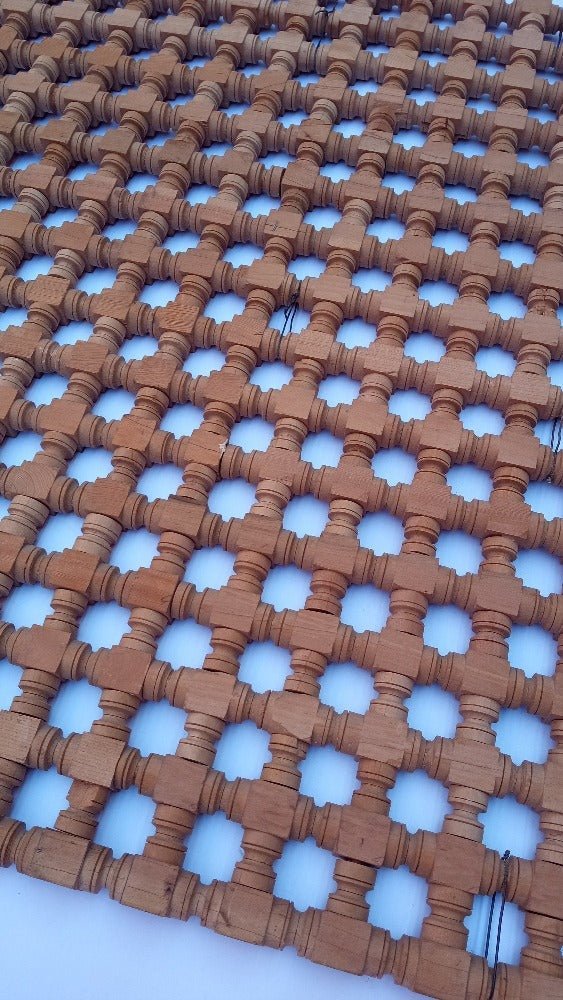
Mashrabiya: The Heart of Moroccan Woodworking Art
Have you ever wondered what gives Moroccan interiors their magical, ethereal glow? The secret lies in an ancient woodworking technique called mashrabiya. These intricate wooden screens are not just beautiful – they're a testament to centuries of craftsmanship and cultural exchange. Let's dive into the enchanting world of mashrabiya and discover how it's shaping modern design trends.
What Exactly is Mashrabiya?
Mashrabiya (also spelled musharabiya or moucharabieh) are ornate wooden lattice screens that have been a staple of Middle Eastern and North African architecture for centuries. But it's in Morocco where these screens truly shine, becoming an integral part of the country's rich woodworking tradition.
Imagine walking into a dim room and seeing patterns of light dancing on the walls – that's the magic of mashrabiya at work.
These screens serve multiple purposes:
- They provide privacy while allowing air to circulate
- They filter harsh sunlight, creating a soft, dappled effect
- They add a touch of artistic flair to any space
The Artistry Behind Mashrabiya
Creating a mashrabiya screen is no easy feat. It requires patience, precision, and years of practice. Moroccan artisans use a variety of techniques to craft these masterpieces:
- Hand carving: Each piece is meticulously carved to fit perfectly into the overall design
- Lathe turning: For creating rounded elements that add depth to the pattern
- Inlay work: Combining different types of wood or materials for added visual interest
The most common woods used in mashrabiya include cedar, walnut, and olive – all prized for their durability and natural beauty.
Mashrabiya in Modern Design
While mashrabiya has its roots in traditional architecture, it's experiencing a renaissance in contemporary design. Interior designers and architects around the world are incorporating mashrabiya-inspired elements into their projects. Here's why:
- Sustainable design: Mashrabiya naturally regulates temperature, reducing the need for air conditioning
- Versatility: It can be used in various settings, from homes to hotels to office spaces
- Unique aesthetic: The intricate patterns add a touch of exotic elegance to any room
Beyond Mashrabiya: Other Moroccan Woodworking Wonders
While mashrabiya steals the spotlight, Moroccan woodworking art encompasses so much more.
Let's take a quick look at some other stunning examples:
- Moroccan doors: Elaborately carved entryways that serve as works of art in themselves
- Thuya wood inlay: Delicate patterns created using the aromatic wood of the thuya tree
- Sculptural furniture: Tables, chairs, and cabinets that blur the line between function and art
Preserving a Cultural Treasure
As with many traditional crafts, there's a growing concern about preserving the art of mashrabiya and Moroccan woodworking for future generations. Initiatives are underway to support artisans and promote their skills both locally and internationally.
By appreciating and investing in these beautiful creations, we're not just decorating our homes – we're helping to keep a rich cultural tradition alive.
Bring the Magic of Mashrabiya Into Your Home
Inspired to add a touch of Moroccan elegance to your space? Here are some ideas:
- Install a mashrabiya screen as a room divider
- Use mashrabiya-inspired patterns in your textiles or wallpaper
- Incorporate a Moroccan wooden side table or cabinet into your decor
Remember, every piece of Moroccan woodworking art tells a story – a story of skilled hands, cultural exchange, and timeless beauty. By bringing these pieces into our homes, we're not just decorating; we're connecting with a rich artistic heritage that spans centuries.
So, the next time you see sunlight filtering through an intricate wooden screen, take a moment to appreciate the artistry of mashrabiya. It's more than just a beautiful design element – it's a window into the soul of Moroccan craftsmanship.







